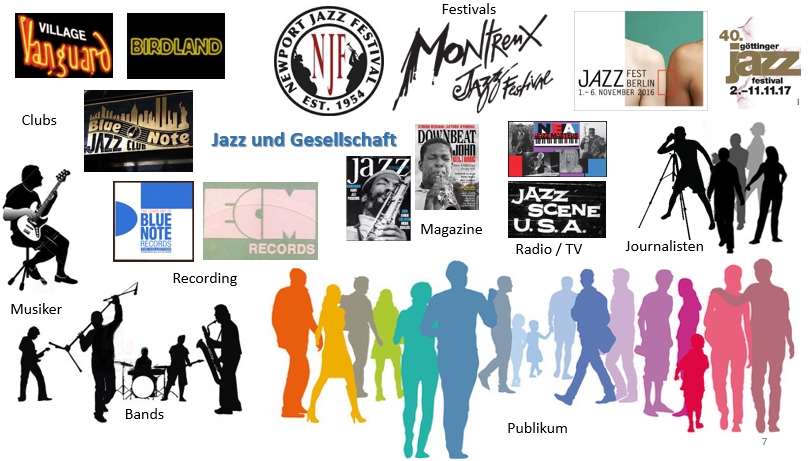Was macht den Jazz aus, wo unterscheidet er sich von allen anderen musikalischen Genres?
- als musikalisches Ereignis, d.h. was passiert da anderes, was begeistert uns (oder andere nicht … warum auch immer)
- als musikalische Differenz: was machen die Musiker anders als ihre Kollegen
- als gesellschaftliche Dimension: was ist die Jazz-Szene? Worin unterscheidet sie sich von anderen musikalischen Unterhaltungsformen?

Wie hat sich diese Musikform entwickelt?
- Aus dem musikalischen Fundus (europäische, (west-)afrikanische, kreolische Musiktraditionen, Musikpraxis, Musik im Alltag), wo hat es angefangen, welche Wege waren entscheidend, von 1850 bis heute?
- Jazz ist in Nordamerika entstanden, hat aber die ganze Welt begeistert, ist zu einer weltumspannenden Musikform herangereift, die heute mehr in Europa stattfindet, aber die Musiken der ganzen Welt assimiliert.
- Jazz-Musiker sind oftmals als Vertreter eines bestimmten Stils auf weltweite Tourneen gegangen, sind aber oft bereichert durch das, was sie dort zu hören und sehen bekamen, zurückgekehrt. So hat sich im Rahmen der Globalisierung auch der Jazz globalisiert, hat Instrumente, Folklore und Lebensgefühle anderer als amerikanischer Regionen hinzugewonnen.
- Der Jazz hat sich in zeitlichen Epochen, in diversen Stilen entwickelt. Die Instrumente des Jazz im einzelnen wurden durch Ihre Protagonisten, die besonders prägenden Musiker, immer wieder variiert. Jazz-Performances reichen von Solo, über kleine Formationen bis hin zur Big Band und es gibt auch Experimente mit großem Orchester oder Chören.
Roots of Jazz
African and European Fusion
- African music featured complex cross-rhythms, slurs, melissma, falsetto, vibrato and simple melodies.
- Call and response form was employed. The leader would throw out a line and a chorus responded.
- Griots were African historians who kept complex records in their heads and related them via song. The Blues form may have derived from this West African culture.
- Derision songs were popular.
- European music featured complex melodies and simple rhythms.
Characteristics of Early African-American Music
- Off beat and syncopated to simulate the complex cross-rhythms.
- Based primarily on the pentatonic scale and other truncated scales.
- Employed blue notes (flatted thirds, sevenths and later fifths) to eliminate half steps.
- Ensemble style singing employed (no true harmony).
Types of Early African-American Music
- Work songs were sung to ease the pain of hard work.
- Field hollers.
- Boat songs.
- Corn shucking songs, etc.
- Spiritual songs were songs based on white hymns and spirituals meant to praise God.
- Lining out, a call and response form derived from African and British roots, was used in white and black churches because there was not enough money for hymn books.
- Camp meetings and ring shouts became popular in black and white churches.
- In the early 1800s, white and black churches split and their Spirituals took separate paths.
- Street vendors‘ songs were another form of early African-American music.
- There were also play songs.
- Prison songs, which contributed to the Blues, were heard after the Civil War and Reconstruction.
Four distinct fusions have occurred:
- Early African-American folk music was a fusion of African and European musics to form work songs, etc.
- Europeanized African-American folk music was a fusion of African-American folk and European music to form Spirituals, Minstrelsy, Vaudeville, etc.
- Ragtime was another fusion of African-American folk with European band music.
- Jazz-Rock or Fusion is a fusion of Jazz and its distant derivative, Rock.